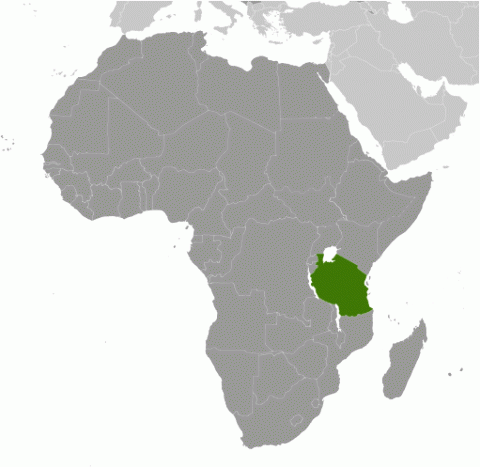Child Labor and Forced Labor Reports
Tanzania


Moderate Advancement
In 2024, the United Republic of Tanzania made moderate advancement in efforts to eliminate the worst forms of child labor. The government passed amendments to the Cyber Crimes Act, the Law of the Child Act, and the Anti-Trafficking in Persons Act, which, respectively, strengthened protections against child sexual exploitation and child pornography, increased minimum penalties for offenses against the rights of a child, and created an Anti-Trafficking Secretariat while calling for stricter penalties for trafficking in persons. The government also launched the National Plan of Action to End Violence Against Women and Girls and a project to promote decent work and reduce child labor in the cotton sector as part of the South-South Cooperation Program, a collaboration with the International Labor Organization and the Government of Brazil. However, despite these efforts, gaps remain in the legal framework and enforcement of laws related to child labor, including the lack of penalties for the use of children in illicit activities, the lack of minimum age protections for children engaged in domestic work, the lack of a legal standard mandating free basic education for children, and an insufficient number of labor inspectors and funding to monitor Tanzania’s labor force.
| Children | Age | Percent and Population |
|---|---|---|
| Working | 5 to 14 | 20.4% (3,345,516) |
| Hazardous Work by Children | 15 to 17 | Unavailable |
| Attending School | 5 to 14 | 83.5% |
| Combining Work and School | 7 to 14 | 18.4% |
| Sectory/Industry | Percent of Population |
|---|---|
| Agriculture | 84.8% |
| Industry | 0.6% |
| Services | 14.5% |
| Sector/Industry | Activity |
|---|---|
| Agriculture | Working in agriculture, including plowing, weeding,† harvesting,† and processing of crops, including cloves, coffee, rice, sisal, tea, and tobacco; fishing† of Nile perch; and herding of livestock, including cattle. |
| Industry | Mining,† including gold, sometimes with the use of mercury, and tanzanite, and quarrying† for production of stone. |
| Services | Domestic work, working in bars,† and street work, including vending,† shining shoes, and scavenging.† |
| Categorical Worst Forms of Child Labor‡ | Forced labor in domestic work, tobacco farming, fishing, mining, quarrying, street begging, street activities such as shining shoes and pushing carts, and working in factories and bars, as well as commercial sexual exploitation, sometimes as a result of human trafficking. |
† Determined by national law or regulation as hazardous and, as such, relevant to Article 3(d) of ILO C. 182.
‡ Child labor understood as the worst forms of child labor per se under Article 3(a)–(c) of ILO C. 182.
Children at Higher Risk
Human traffickers exploit children from Burundi through domestic work and commercial sexual exploitation. Burundian children who are victims of human trafficking are also forced to cultivate maize, cassava, and other crops, in which they endure long hours, sleeping in the fields with little food which supervisors sometimes lace with hemp to increase productivity, expulsion without pay, abuse, torture, and arrest. Refugee children living in Tanzania are also increasingly subjected to commercial sexual exploitation and forced labor in farming in western Tanzania. In addition, children from underserved communities, particularly impoverished orphans and children with disabilities from rural areas, are frequently subjected to forced labor and commercial sexual exploitation. Finally, children in rural areas are vulnerable to child labor in agriculture and artisanal mining, and to human trafficking to urban centers, especially for domestic work.
Barriers to Education Access
Schools, particularly in rural areas, lack adequate teachers, classrooms and desks, and sanitation facilities, which disproportionately impacts girls. Families are often required to financially contribute to offset these deficits and pay for the costs of uniforms and learning materials. Schools are also not sufficiently equipped to serve children with disabilities and learning difficulties. In 2021, the government reversed its longstanding practice of expelling girls who became pregnant from school. However, girls can still be removed from school during the duration of their pregnancy, which reduces the likelihood that they will return to education.
| Standard | Age | Meets International Standards | Legislation |
|---|---|---|---|
| Minimum Age for Work | 14 | ✗ | Articles 5 and 102 of the Employment and Labor Relations Act; Article 77 of the Law of the Child Act |
| Minimum Age for Hazardous Work | 18 | ✓ | Articles 5 and 102 of the Employment and Labor Relations Act; Article 82 of the Law of the Child Act |
| Identification of Hazardous Occupations or Activities Prohibited for Children | ✓ | Article 5 and First Schedule of Regulations of the Employment and Labor Relations Act; Article 82 of the Law of the Child Act | |
| Prohibition of Slavery, Debt Bondage, and Forced Labor | ✓ | Article 6 of the Employment and Labor Relations Act; Articles 80 and 81 of the Law of the Child Act; Article 25 of the Constitution; Articles 3–5 of the Anti-Trafficking in Persons Act | |
| Prohibition of Child Trafficking | ✓ | Article 3–5 of the Anti-Trafficking in Persons Act; Articles 80 and 81 of the Law of the Child Act | |
| Prohibition of Commercial Sexual Exploitation of Children | ✓ | Article 138.2.f of the Sexual Offenses Special Provisions Act; Articles 3–5 of the Anti-Trafficking in Persons Act; Section 83 of the Law of the Child Act; Section 155.(1) of the Penal Decree Act; Article 5 of the Child Protection Laws (Miscellaneous Amendments) Act, 2024, which adds Article 13(2)(b) and 13(3) to the Cyber Crimes Act | |
| Prohibition of Using Children in Illicit Activities | ✗ | ||
| Minimum Age for Voluntary State Military Recruitment | ✗ | Article 29 of the National Defense Act | |
| Prohibition of Compulsory Recruitment of Children by (State) Military | N/A | ||
| Prohibition of Military Recruitment by Non-state Armed Groups | ✗ | ||
| Compulsory Education Age | 13 | ✗ | Article 35 of the National Education Act |
| Free Public Education | ✗ | Articles 10 and 35 of the National Education Act |
In 2024, the government passed amendments to improve anti-trafficking in persons and child protection legislation. The Cyber Crimes Act was amended to provide definitional clarity on child sexual abuse material, child sexual exploitation material, and child pornography, and to criminalize the possession, distribution, and creation of child sexual abuse material, the grooming of a child, and arranging to meet or solicit a child through a computer for sexual purposes. Additionally, the Law of the Child Act was amended to increase minimum penalties for offenses contravening the rights of a child, and the Anti-Trafficking in Persons Act was amended to create an Anti-Trafficking Secretariat.
Although the Mainland government has a list of hazardous work activities for children, the types of hazardous work prohibited for children do not cover work in weeding and processing in the production of tobacco, cloves, coffee, sisal, and tea, areas of work in which there is evidence of unhealthy environments and use of dangerous equipment and tools. The Mainland government also does not stipulate penalties for using children for illicit activities, including in the production and trafficking of drugs. In addition, minimum age for work laws in Mainland Tanzania and Zanzibar do not meet international standards because they do not extend to all working children, including children engaged in domestic work. Furthermore, as the compulsory education age in both the Mainland and Zanzibar is below the minimum age for work, children are vulnerable to child labor because they are not required to attend school but are not legally permitted to work. The Mainland also lacks a legal standard mandating free basic education for children, though it supports free basic education through a policy. However, the National Education Act authorizes local education authorities to assess school fees at their discretion, which may contravene any future legal standards to provide free basic education. Finally, the law on state voluntary military recruitment falls below international standards because it sets no minimum age for recruitment with a guardian’s permission, nor does it establish sufficient safeguards for voluntariness.
| Organization/Agency | Role & Activities |
|---|
| Prime Minister’s Office for Labor, Youth, Employment, and Persons with Disability (PMO-LYED): The Minister of State oversees work to assign area labor officers in each region to respond to reports of child labor violations, issue non-compliance orders, and report incidents to police and relevant ministries. Through its Labor Administration and Inspection Section, provides legal guidance upon request, disseminates information to employers and employees on their rights and obligations, and helps area offices conduct labor inspections. Coordinates with the Ministry of Community Development, Gender, Women, and Special Groups, which employs officers to monitor child labor at the district and village levels and reports back to PMO-LYED. In Zanzibar, the Zanzibar Labor Commission ensures compliance with child protection and child labor laws, including inspections, through its Child Protection Unit. It employs labor inspectors who investigate child labor cases reported by the police and refer cases to social welfare officers. |
| Ministry of Home Affairs and Tanzanian Police Force: The Ministry of Home Affairs chairs the Anti-Trafficking Secretariat, which coordinates the government’s anti-trafficking efforts. The Tanzanian Police Force investigates cases of child labor and other forms of child endangerment reported to police stations. |
| Overview of Enforcement Efforts | 2024 |
|---|---|
| Has a Labor Inspectorate | Yes |
| Able to Assess Civil Penalties | Yes |
| Routinely Conducted Worksite Inspections | Yes |
| Unannounced Inspections Permitted | Yes |
| Has a Complaint Mechanism | Yes |
| Imposed Penalties for Child Labor Violations | No |
| Conducted Criminal Investigations for Worst Forms of Child Labor Crimes | Yes |
| Imposed Penalties for Worst Forms of Child Labor Crimes | Yes |
In 2024, 92 labor inspectors conducted 19,040 worksite inspections, and the number of violations of child labor is unknown. It is also unknown how many investigations into the worst forms of child labor were conducted, but there were at least 17 prosecutions and 4 convictions.
| Coordinating Body | Role & Activities |
|---|
| National Education Task Force on Child Labor: Reviews existing laws, regulations, and strategies related to children’s issues, including the National Strategy on the Elimination of Child Labor. Evaluates educational curriculum and programs, identifies gaps, and suggests strategies to resolve barriers to accessing education. In 2024, the Task Force held quarterly meetings to discuss challenges in coordination and reporting. |
| Policy | Description & Activities |
|---|
| National Strategy on Elimination of Child Labor (2024/25–2028/29):* Launched in June 2024, outlines strategies to prevent and respond to the worst forms of child labor at the national level. |
| National Plan of Action to End Violence Against Women and Children (2024/25–2028/29):* Launched in May 2024, provides strategic interventions to create a unified protection system for women and children, including an emphasis on eliminating child labor and trafficking in persons. |
| National Action Plan for Artisanal and Small-Scale Gold Mining (2020–2025): Promotes the reduction and elimination of mercury use in artisanal and small-scale gold mining, strengthening legal and public health frameworks, and building institutional capacity. Includes a call to action against child labor. |
* Policy was approved during the reporting period.
† The government has other policies that may have addressed child labor issues or had an impact on child labor.
| Program | Description & Activities |
|---|
| Tanzania Social Action Fund Conditional Cash Transfer Program (2020–2025):‡ Government-funded conditional cash transfer program to provide financial assistance to vulnerable populations, including children. Also manages Zanzibar’s Productive Social Safety Net fund, which provides conditional cash transfers to 33,523 households experiencing extreme poverty and other vulnerabilities to child labor. During the reporting period, the government encouraged school enrollment and withheld cash transfers to those who failed to comply. The Tanzania Social Action Fund Conditional Cash Transfer Program was extended to October 2025. |
| Promoting Sustainable Practices to Eradicate Child Labor in Tobacco Growing Areas/Rural Enterprise Support to Eliminate Child Labor Project: Funded by the Eliminating Child Labor in Tobacco Growing Foundation, aims to strengthen the child labor referral, response, and reporting system by training community and district committees on monitoring, referral, and reporting procedures in Chunya, Kaliua, Sikonge, Songwe, Tabora, and Urambo. In 2024, 6,722 children aged 5 to 17 were indirectly prevented from child labor, and 6,101 community members and district-level officials were reached by awareness-raising efforts. |
| Promotion of Decent Work in the Cotton Value Chain in Tanzania Project: The government, in collaboration with Government of Brazil and the ILO, launched this $558,000 project as part of the ILO-Brazil South-South Cooperation Program 2023–2027. This program aims to eliminate child labor among cotton growers and promote decent work in the cotton supply chain in the Simiyu region by strengthening the labor inspection system, promoting better occupational safety and health, and expanding social security coverage in cotton-producing areas. |
‡ Program is funded by the Government of Tanzania.
† The government had other social programs that may have included the goal of eliminating or preventing child labor.
| Area | Suggested Action |
|---|---|
| Legal Framework | Extend the minimum age for work protections so that they apply to all children, including those engaged in domestic work. |
| Expand the list of hazardous occupations and activities prohibited for children under 18 to include weeding and processing in the production of tobacco, cloves, coffee, sisal, and tea. | |
| Criminalize the use of children in illicit activities, particularly in the production and trafficking of drugs. | |
| Criminalize the recruitment of children under age 18 by non-state armed groups. | |
| Increase the compulsory education age from age 13 to age 14 to align with the minimum age for work. Establish by law free basic public education and remove legal authority of local education authorities to assess discretionary education fees. | |
| Ensure that the law establishes 16 or 17 as the minimum age for voluntary recruitment by the state military with additional safeguards for voluntariness, which may include but not be limited to guardian’s permission. | |
| Enforcement | Increase budgetary resources for the child labor complaint mechanism so that it can fully carry out its operations. |
| Implement a digital tracking system for civil worst forms of child labor inspections. | |
| Increase operational resources, including office facilities, vehicles, fuel, and equipment for the labor inspectorate, and increase the number of labor inspectors from 92 to 643 to ensure adequate coverage of the labor force of approximately 25.7 million people. | |
| Ensure that the number of labor inspections conducted is commensurate to the size of the labor inspectorate to maintain adequate quality and scope of inspections. | |
| Develop a mechanism for the centralized collection and publication of data related to the worst forms of child labor, including the number of investigations, prosecutions, convictions, and imposed penalties for violations. | |
| Coordination | Ensure that the National Education Task Force on Child Labor is able to carry out its intended mandates, including detailed reporting. |
| Government Policies | Eliminate provisions in the Primary School Leaving Examination that prohibit children who initially fail the exam from retaking it for consideration in secondary school admission. |
| Social Programs | Facilitate reenrollment of girls who leave school during pregnancy. |
| Make education accessible to all children in Tanzania, including those living in rural areas, by ensuring adequate resources for children with disabilities; increasing resources for teachers, classrooms and desks, food, and sanitation facilities; and defraying informal costs imposed on families, including for school uniforms, books, and other learning materials. | |
| Harmonize child labor prevention and elimination measures into the Social Action Fund Conditional Cash Transfer Program to increase its effectiveness. | |
| Develop programs that include children engaged in child labor in the domestic work, fishing, and informal sectors. |












